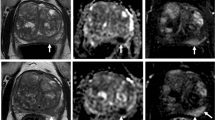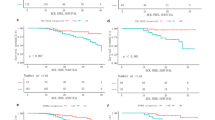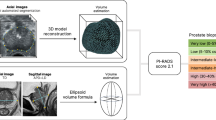Abstract
Objective
To evaluate the trend that despite recent advances in the screening, diagnosis, and management of prostate cancer (PCa), African-Americans (AAs) continue to have poorer outcomes compared to their Caucasian (CAU) counterparts. The reason for this may be rooted in biological differences in the cancer between the two groups; however, there may be some inherent disparities within the efficacy of the screening modalities. In this study, we aim to evaluate the negative predictive value (NPV) of multi-parametric MRI (mpMRI) between AA compared to CAUs.
Methods
All mpMRI between January 2014 and June 2017 were evaluated. The MRIs were read by dedicated genitourinary radiologists. Subsequently, the readings were correlated to final pathology after the patients underwent radical prostatectomy. The NPV and negative likelihood ratios (−LR) of mpMRI were evaluated in AAs versus CAUs based on four cutoffs (≥ Grade I, ≥ Grade II, ≥ Grade III and ≥ Grade IV).
Results
The mpMRI was almost equally as effective between AAs and CAUs in excluding Grade III (NPV = 89 and 94, respectively), and Grade IV or above (NPV = 96 and 98, respectively) PCa; however, the NPV of mpMRI was significantly lower for Grade I (NPV = 32 and 52, respectively) and Grade II (NPV = 50 and 79, respectively) PCa.
Conclusion
Despite advances in the screening for PCa, there are disparities noted in the efficacy of screening tools between AAs and CAUs. For this reason, patients should be risk stratified and their screening results should be evaluated with consideration given to their baseline risk.


Similar content being viewed by others
Abbreviations
- AA:
-
African-American
- CAU:
-
Caucasian
- mpMRI:
-
Multi-parametric magnetic resonance imaging
- NPV:
-
Negative predictive value
- PCa:
-
Prostate cancer
- PI-RADS:
-
Prostate Imaging Reporting and Data System
- PSA:
-
Prostate-specific antigen
- csPCa:
-
Clinically significant prostate cancer
- EAU:
-
European Association of Urology
- PSAD:
-
PSA density
References
Siegel RL, Miller KD, Jemal A (2015) Cancer statistics, 2015. CA Cancer J Clin 65(1):5–29
Gordetsky JB et al (2018) Prostate cancer management choices in patients undergoing multiparametric magnetic resonance imaging/ultrasound fusion biopsy compared to systematic biopsy. Urol Oncol 36(5):241 (e7–241 e13)
Valerio M et al (2015) Detection of clinically significant prostate cancer using magnetic resonance imaging-ultrasound fusion targeted biopsy: a systematic review. Eur Urol 68(1):8–19
Schoots IG et al (2015) Magnetic resonance imaging-targeted biopsy may enhance the diagnostic accuracy of significant prostate cancer detection compared to standard transrectal ultrasound-guided biopsy: a systematic review and meta-analysis. Eur Urol 68(3):438–450
Wegelin O et al (2017) Comparing three different techniques for magnetic resonance imaging-targeted prostate biopsies: a systematic review of in-bore versus magnetic resonance imaging-transrectal ultrasound fusion versus cognitive registration. Is there a preferred technique? Eur Urol 71(4):517–531
Schoots IG (2016) Omission of systematic transrectal ultrasound guided biopsy from the MRI targeted approach in men with previous negative prostate biopsy might still be premature. Ann Transl Med 4(10):205
Moldovan PC et al (2017) What is the negative predictive value of multiparametric magnetic resonance imaging in excluding prostate cancer at biopsy? A systematic review and meta-analysis from the European association of urology prostate cancer guidelines panel. Eur Urol 72(2):250–266
Nettey OS et al (2018) Self-reported Black race predicts significant prostate cancer independent of clinical setting and clinical and socioeconomic risk factors. Urol Oncol 36(11):501 (e1–501 e8)
Odedina FT et al (2009) Prostate cancer disparities in Black men of African descent: a comparative literature review of prostate cancer burden among Black men in the United States, Caribbean, United Kingdom, and West Africa. Infect Agent Cancer 4(Suppl 1):S2
Shenoy D et al (2016) Do African-American men need separate prostate cancer screening guidelines? BMC Urol 16(1):19
Sundi D et al (2014) Pathological examination of radical prostatectomy specimens in men with very low risk disease at biopsy reveals distinct zonal distribution of cancer in black American men. J Urol 191(1):60–67
Wang M et al (2019) Whole mount histopathological correlation with prostate MRI in Grade I and II prostatectomy patients. Int Urol Nephrol 51(3):425–434
Ajayi A et al (2016) Disparities in staging prostate magnetic resonance imaging utilization for nonmetastatic prostate cancer patients undergoing definitive radiation therapy. Adv Radiat Oncol 1(4):325–332
Powell IJ et al (2010) Evidence supports a faster growth rate and/or earlier transformation to clinically significant prostate cancer in black than in white American men, and influences racial progression and mortality disparity. J Urol 183(5):1792–1796
Team R (2013) R development core team. RA Lang Environ Stat Comput 55:275–286
Sundi D et al (2013) African American men with very low-risk prostate cancer exhibit adverse oncologic outcomes after radical prostatectomy: should active surveillance still be an option for them? J Clin Oncol 31(24):2991–2997
Mahal BA et al (2018) Prostate cancer-specific mortality across Gleason scores in black vs nonblack men. JAMA 320(23):2479–2481
Barrett T, Haider MA (2017) The emerging role of MRI in prostate cancer active surveillance and ongoing challenges. AJR 208(1):131–139
Hoffmann R et al (2018) Does the Prostate Imaging-Reporting and Data System (PI-RADS) version 2 improve accuracy in reporting anterior lesions on multiparametric magnetic resonance imaging (mpMRI)? Int Urol Nephrol 50(1):13–19
Polanec S et al (2016) Head-to-head comparison of PI-RADS v2 and PI-RADS v1. Eur J Radiol 85(6):1125–1131
Funding
None.
Author information
Authors and Affiliations
Contributions
Conception and design: AMKM, LP. Administrative support: CN, VG, LP. Provision of study material or patients: AM, CB. Collection and assembly of data: KM, AQ, LB, AM. Data analysis and interpretation: AM, LB, KM. Manuscript writing: all authors. Final approval of manuscript: all authors.
Corresponding author
Ethics declarations
Conflict of interest
Amr Mahran, MD, declares that he has no conflict of interest. Kirtishri Mishra, MD, declares that he has no conflict of interest. Laura Bukavina declares that she has no conflict of interest. Fredrick Schumacher, PhD, declares that he has no conflict of interest. Anna Quian, BS, declares that she has no conflict of interest. Christina Buzzy, PhD, declares that she has no conflict of interest. Carvell T. Nguyen, MD, PhD, declares that he has no conflict of interest. Vikas Gulani, MD, PhD, declares that he has no conflict of interest. Lee E. Ponsky, MD, declares that he has no conflict of interest.
Ethical approval
All procedures performed in studies involving human participants were in accordance with the ethical standards of the institutional and/or national research committee and with the 1964 Helsinki Declaration and its later amendments or comparable ethical standards.
Informed consent
Due to the retrospective nature of the study, informed consent was waived per IRB review protocol.
Additional information
Publisher's Note
Springer Nature remains neutral with regard to jurisdictional claims in published maps and institutional affiliations.
Rights and permissions
About this article
Cite this article
Mahran, A., Mishra, K., Bukavina, L. et al. Observed racial disparity in the negative predictive value of multi-parametric MRI for the diagnosis for prostate cancer. Int Urol Nephrol 51, 1343–1348 (2019). https://doi.org/10.1007/s11255-019-02158-6
Received:
Accepted:
Published:
Issue Date:
DOI: https://doi.org/10.1007/s11255-019-02158-6




